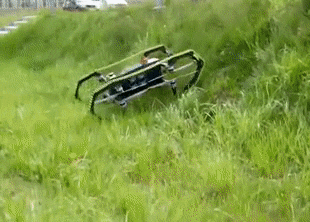The European project HUUVER showed tests of its crawler robot with propellers. He rode down a slide of rocks, descended a grassy slope and took off.
 |
| HUUVER. |
| Source: nplus1.ru |
Crawler robots and multicopters have their advantages. The former can carry large loads and spend little energy on it. But they often cannot overcome obstacles that are large relative to their size. The latter move through the air, so they are not so sensitive to the complexity of the terrain. However, multicopters usually cannot compare with ground robots in terms of mission duration.
Polish companies Dronehub and Rectangle together with Czech Gina Software, Austrian Bladescape and Brimatech Services, Spanish NTT Data and Finnish Lappeenranta University of Technology founded the HUUVER project and created a tracked platform with propellers.
On February 16, the HUUVER project published a video of testing a prototype of the robot of the same name. HUUVER has shown that he is able to move on difficult surfaces, such as piles of stones and bricks, and fly.
The prototype is 137 centimeters long, 84 wide, 56 tall and weighs 23 kilograms. During ground missions, the drone tank can operate for up to 10 hours on a single charge of its lithium battery. It takes off with the help of eight propellers located inside the tracked platforms. HUUVER can spend up to 20 minutes in the air.
The device can be remotely controlled by operators, but it can also fly autonomously. It is equipped with a Sony 4K optical camera, thermal imager, Galileo satellite navigation system, lidar and Nvidia Jetson AGX Xavier microprocessor.
Dronehub says that the project has already passed the research and development stage and moved on to commercialization. But it is not yet known when the robot can be bought. Most likely, it will find application in industrial, military and rescue missions.
HUUVER is not the only hybrid of a ground robot and a flying drone. Earlier we wrote about a Korean quadcopter with wheels, an American drone-SUV and a Chinese biped robot that can rise into the air and hang in one place.
Vasilisa Chernyavtseva
